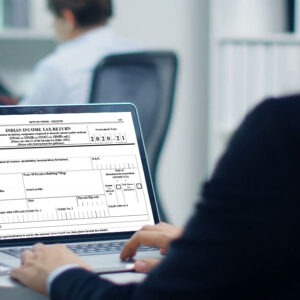ITR-5 Return Filing
₹7,550.00 – ₹10,601.00
Income tax return filing for a taxpayer with taxable income of less than Rs.10 lakhs.
Offers and discounts
| Accounting Software 1 Year, Unlimited Users LEDGERS License |
| GST Invoice Save 18% by Availing GST Credit on Purchases |
Description
ITR 5 Form Filing
The taxpayers are supposed to file the Income Tax returns based on the income that is earned by them in the financial year and the kind of entity that it falls under. ITR 5 Form filing is to be done by the Association of Persons, Limited Liability Partnerships, Body of Individuals, Estates of the deceased, Artificial judicial person, business trust, estates of the insolvent, business trust, and investment fund.
This article is a comprehensive guide you can refer to while filing the Income Tax returns in Form 5.
Who is Eligible to file ITR 5 Form?
ITR 5 can be filed by the following people :
- A firm
- A Limited Liability Partnership
- Association of Persons
- Body of Individuals
- Artificial Judicial Persons that are referred to in Section 2 (31) (vii)
- The local authority that is referred to in Section 160(1) (ii) or 160 (1) (iv)
- Cooperative Society
- Societies that are registered under Societies Registration Act, 1860 or under any state law trust ( except the trusts that are eligible for ITR 7 Form Filing)
- Estate of the deceased person
- Business trust referred to in Section 139 (4E)
- Investment fund referred to in Section 139 (4F)
Who is not eligible to file Form ITR 5?
An individual who has to file income tax returns under the Section 139 (4A) or 139 (4D) cannot file ITR 5 Form.
Instructions to be followed while ITR 5 Form
- If the schedule is not applicable, Not Applicable has to be mentioned.
- If the item is inappropriate write “NA” against the item.
- The “Nil” stands for nil figures which identify the figures of zero value.
- For a negative figure denote it with “-” before the figure other than which is provided in the Form.
- All the figures are denoted in the round-off manner to the nearest one rupee.
- Similarly, the figures for the total income and the payable tax should be rounded off to the nearest multiple of ten rupees.
Presumptive Taxation Scheme
What are the features of the Presumptive Taxation Scheme?
- Under presumptive taxation scheme, there is no requirement to maintain the books of accounts
- The net income is estimated to be 8% of gross cash receipts. However, for payments received via digital mode, the net income is assumed to be 6% of such gross receipts.
- Deduction of any business expense against this income is not allowed.
- The business owner has to pay 100% Advance Tax by the 15th of March. There is no need to comply with quarterly installments of due dates of Advance tax (i.e. in June, Sep, Dec)
Procedure for filing ITR 5 Form
How to File ITR 5 Form?
The ITR 5 Form can be filed with the Income Tax Department either online or offline.
Offline Filing: The Form can be filed offline by furnishing the return in a paper form or by furnishing the bar-coded return. When the return is filed on paper an acknowledgment slip is paired along with the return form that is to be filed properly.
Online Filing: ITR 5 Form can be filed online by furnishing the return electronically using the Digital Signature Certificate.
Or
By transmitting the data in the returns electronically followed by the submission of the return verification in the ITR V Form.
While online filing the assessee is needed to print the copies of the ITR V Form. One copy of the ITR V must be duly signed by the assessee needs to be sent to
Post Bag No. 1,Electronic City Office,
Bengaluru–560100,
(Karnataka). via ordinary post.
The other copy should be kept by the assessee with himself as a record.
A firm should mandatorily furnish the return electronically under the digital signature of whose accounts are liable to audit under Section 4AB.
Is ITR 5 Form an annexure-less form?
ITR 5 Form is an annexure-less form and it should be attached with the return form while filing ITR 5. All the documents that are enclosed with this Form will be detached and returned to the person that is filing the returns. The taxpayers are advised to match the taxes that are deducted/ collected /paid by or on behalf of them with their Tax Credit Statement Form 26AS.
How to fill the verification document?
Fill up the required information in the verification document.
It is necessary to strike out whatever is not applicable. Please ensure that the verification has been signed before furnishing the return.
Choose the designation or the capacity of the person who is signing the return.
Any person making a false statement in the return or the accompanying schedules will be liable to be prosecuted under Section 277 of the Income Tax Act,1961, and on Conviction, it is punishable under that section with rigorous imprisonment and with fine.
Structure of ITR 5 Form
| Part/Schedule | Explanation |
|---|---|
| Part A-GEN | General information |
| Part A-BS | Balance sheet as on the last day of the previous year |
| Part A – Manufacturing Account | Manufacturing Account for the previous financial year |
| Part A – Trading Account | Trading Account for the previous financial year |
| Part A – P&L | Profit and Loss for the previous financial year |
| Part A – OI | Other Information (this is optional in case the assessee is not liable for audit under Section 44AB) |
| Part A – QD | Quantitative Details (this is optional in case the assessee is not liable for audit under Section 44AB) |
| Schedule- HP | Income computation under the head House Property |
| Schedule – BP | Income computation under the head – Business or Profession |
| Schedule DPM | Computing depreciation on Plant & Machinery under the Income Tax Act |
| Schedule DOA | Computation of Depreciation on other assets as per the Income Tax Act |
| Schedule DEP | Summary of depreciation on all assets as per the Income Tax Act |
| Schedule DCG | A computing of deemed capital gains on the sale of depreciable assets |
| Schedule ESR | Making deduction under Section 35 |
| Schedule- CG | Computing income under the head Capital Gains |
| Schedule- OS | Computing income under the heading Income from other sources |
| Schedule CYLA | Income statement after setting-off losses for the current year |
| Schedule BFLA | Income statement after setting off the unabsorbed losses of the previous year(s) |
| Schedule CFL | Statement of losses which is to be carried forward to the future years |
| Schedule UD | Statement regarding unabsorbed depreciation |
| Schedule ICDS | |
| Schedule 10AA | Computing the deduction under Section 10AA |
| Schedule 80G | Statement about donations which are entitled to deduction under Section 80G |
| Schedule RA | Statement of donations made to research associations etc. which are entitled to deduction under Sections 35(1)(ii), 35(1)(iia), 35(1)(iii) or 35(2AA) |
| Schedule 80IA | Computing deduction to be made under Section 80IA |
| Schedule 80IB | Computing deduction under Section 80IB |
| Schedule 80IC/80IE | Computing deduction under Section 80IC/80IE |
| Schedule 80P | Deductions under Section 80P |
| Schedule VIA | Deductions statement under Chapter VIA |
| Schedule AMT | Computing Alternate Minimum Tax under Section 115JC of the Income Tax Act |
| Schedule AMTC | Calculation of tax credit under Section 115JD |
| Schedule SPI | Statement of income that arises to minor child/spouse/son’s wife or any other person or AOP that is to be included in the income of the assessee in Schedules HP, CG, OS |
| Schedule SI | Statement of income which is subject to chargeability at special tax rates |
| Schedule IF | Details of partnership firms in which assessee is a partner |
| Schedule EI | Exempt Income Details |
| Schedule PTI | Details of pass-through income from an investment fund or business trust under Section 115UA, 115UB |
| Schedule FSI | Details of income that accrues or arises out of India |
| Schedule TR | Details of any taxes that have been paid outside India |
| Schedule FA | Details of any Foreign assets or income from a source outside India |
| Schedule GST | Details of turnover/gross receipts reported for GST |
| Part B-TI | Summary of total income and tax computation based on the income that is chargeable to tax |
| Part B – TTI | Computing the tax liability on total income |
| Tax Payments | Advance Tax, Tax Deducted at Source and Self-assessment tax |
E filing Audit Reports
It is mandatory for the assessee to furnish the audit report under Sections 10 (23C) (v), 10 (23C) (vi), 10 (23C) (via), 10A, 10AA, 12 A (1) (b), 44AB, 44DA, 50B, 80 IA, 80 IB, 80 IC, 80 ID, 80 JJ AA, 80 LA, 92 E, 115 JB, or 115VW, electronically or before the date of filing the income tax returns.
The due date for filing ITR 5 Form for the AY 2021 – 2022.
The due date for Filing ITR 5 Form for the AY 2021 – 2022 for Non- Audit Case is 31st July 2021 and 31st October 2021 for Audit cases.
Amendments made in the ITR V Form for the financial year 2021-2022
- Details of recognition as a start-up by DPIIT
- Declaration Details filed in Form-2
- Information about the partnership firms where an individual is a partner
- Bifurcation of donations into cash and non-cash mode of payment.
- Information on turnover and the gross receipts reported for GST.
Additional information
| Price | Basic, Standard, Premium |
|---|
Related products
-
- -24%
- Income tax
ITR-2 Return Filing
- ₹1,134.00 – ₹1,897.00
- Select options This product has multiple variants. The options may be chosen on the product page
Add to WishlistAdd to Wishlist -
- -24%
- Income tax
ITR-6 Return Filing
- ₹7,550.00 – ₹15,341.00
- Select options This product has multiple variants. The options may be chosen on the product page
Add to WishlistAdd to Wishlist -
- -24%
- Income tax
ITR-7 Return Filing
- ₹7,550.00 – ₹12,126.00
- Select options This product has multiple variants. The options may be chosen on the product page
Add to WishlistAdd to Wishlist -
- -20%
- Income tax
Form 16 Issuance
- ₹200.00 – ₹300.00
- Select options This product has multiple variants. The options may be chosen on the product page
Add to WishlistAdd to Wishlist








Reviews
There are no reviews yet.